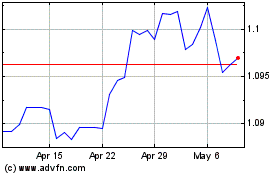Australian, NZ Dollars Climb Amid Rising Risk Appetite
04 January 2018 - 1:22PM
RTTF2
The Australian and the New Zealand dollars climbed against their
major opponents in late Asian deals on Thursday amid rising risk
appetite, as most Asian markets rose following the record closing
highs overnight on Wall Street and as China service sector growth
beat forecasts.
The latest survey from Caixin showed that China services sector
activity continued to expand in December, and at an accelerated
pace, with a PMI score of 53.9.
That's up from 51.9 in November, and it moves further above the
boom-or-bust line of 50 that separates expansion from
contraction.
Strong U.S. manufacturing and construction data coupled with the
Fed minutes showing a continued support for a gradual rate hike
aided sentiment.
Crude prices remained firm on lingering concerns over protests
in Iran, OPEC's third-biggest oil producer.
On the economic front, the latest survey from the Australian
Industry Group showed that the services sector in Australia
continued to expand in December, and at an accelerated pace, with a
Performance of Service Index score of 52.0.
That's up from 51.7 in November, and it moves further above the
boom-or-bust line of 50 that separates expansion from
contraction.
On Wednesday, the aussie was higher against its major rivals,
excepting the greenback. The kiwi was steady against the greenback
and the yen, but higher against the euro.
The aussie reversed from an early low of 0.9809 against the
loonie, rising to 0.9829. If the aussie rises further, 1.00 is
possibly seen as its next resistance level.
The Australian unit hit a 2-day high of 88.34 against the yen,
after having fallen to 88.08 at 5:45 pm ET. The aussie is seen
finding resistance around the 89.5 area.
Survey from Nikkei showed that Japan's manufacturing sector
continued to expand in December, and at an accelerated pace, with a
manufacturing PMI score of 54.0.
That's up from 53.6 in November, and it moves further above the
boom-or-bust line of 50 that separates expansion from
contraction.
The aussie advanced to 0.7842 against the greenback and 1.5326
against the euro, reversing from its prior lows of 0.7814 and
1.5367, respectively. The aussie is likely to challenge resistance
around 0.795 versus the greenback and 1.52 versus the euro.
The kiwi bounced off to 1.6904 against the euro and 1.1025
against the aussie, from its early lows of 1.6975 and 1.1051,
respectively. The next possible resistance for the kiwi is seen
around 1.68 against the euro and 1.09 against the aussie.
The NZ currency climbed to 2-day highs of 0.7113 against the
greenback and 80.08 against the yen, off its previous lows of
0.7073 and 79.74, respectively. Continuation of the kiwi's uptrend
may see it challenging resistance around 0.73 against the greenback
and 82.00 against the yen.
Looking ahead, U.K. mortgage approvals and money supply for
November and PMIs from major economies are set for release in the
European session.
At 8:15 am ET, ADP private payrolls for December are due.
In the New York session, U.S. weekly jobless claims for the week
ended December 30, Markit's services PMI for December and Canada
industrial product price index for November are slated for
release.
AUD vs NZD (FX:AUDNZD)
Forex Chart
From Mar 2024 to Apr 2024

AUD vs NZD (FX:AUDNZD)
Forex Chart
From Apr 2023 to Apr 2024
